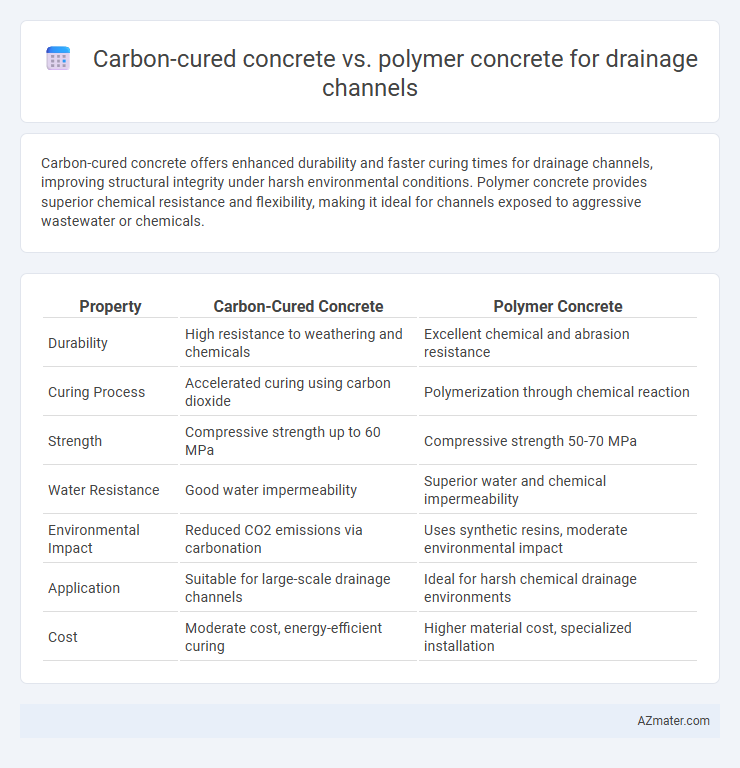Carbon-cured concrete offers enhanced durability and faster curing times for drainage channels, improving structural integrity under harsh environmental conditions. Polymer concrete provides superior chemical resistance and flexibility, making it ideal for channels exposed to aggressive wastewater or chemicals.
Table of Comparison
| Property | Carbon-Cured Concrete | Polymer Concrete |
|---|---|---|
| Durability | High resistance to weathering and chemicals | Excellent chemical and abrasion resistance |
| Curing Process | Accelerated curing using carbon dioxide | Polymerization through chemical reaction |
| Strength | Compressive strength up to 60 MPa | Compressive strength 50-70 MPa |
| Water Resistance | Good water impermeability | Superior water and chemical impermeability |
| Environmental Impact | Reduced CO2 emissions via carbonation | Uses synthetic resins, moderate environmental impact |
| Application | Suitable for large-scale drainage channels | Ideal for harsh chemical drainage environments |
| Cost | Moderate cost, energy-efficient curing | Higher material cost, specialized installation |
Introduction to Carbon-Cured Concrete and Polymer Concrete
Carbon-cured concrete utilizes CO2 curing technology to enhance concrete strength and durability by accelerating the carbonation process, resulting in improved resistance to chemical corrosion and environmental degradation. Polymer concrete incorporates polymer resins as a binder instead of traditional cement, offering superior flexural strength, excellent chemical resistance, and low permeability, ideal for aggressive drainage environments. Both materials provide innovative solutions for drainage channels, optimizing performance with carbon-cured concrete excelling in sustainability and polymer concrete in mechanical resilience.
Material Composition and Chemical Properties
Carbon-cured concrete for drainage channels consists primarily of Portland cement, aggregates, and is exposed to a controlled CO2 curing process that enhances carbonation, resulting in increased compressive strength and reduced permeability. Polymer concrete incorporates thermosetting resins such as epoxy or polyester combined with aggregates, providing superior chemical resistance and improved bonding characteristics compared to traditional cementitious materials. The chemical properties of carbon-cured concrete emphasize calcium carbonate formation that densifies the microstructure, whereas polymer concrete's composition delivers enhanced resistance to acidic and alkali environments, making it highly durable in aggressive drainage conditions.
Manufacturing Process Comparison
Carbon-cured concrete leverages accelerated curing using carbon dioxide, which enhances strength and reduces curing time through a mineralization process that binds CO2 into the concrete matrix. Polymer concrete, in contrast, replaces traditional cement with polymer resins, requiring precise mixing and curing under controlled temperatures to achieve chemical bonding between the aggregate and resin binder. The manufacturing of carbon-cured concrete emphasizes CO2 injection systems and environmental controls, while polymer concrete production relies on resin preparation and thermal curing equipment, making the former more environmentally focused and the latter more chemically intensive.
Strength and Durability in Drainage Applications
Carbon-cured concrete exhibits enhanced compressive strength and resistance to chemical attacks, making it highly durable for drainage channel applications exposed to aggressive environments. Polymer concrete offers superior tensile strength, corrosion resistance, and impermeability, which significantly extend the lifespan of drainage systems subjected to frequent water flow and chemical exposure. Both materials improve structural integrity, but polymer concrete typically provides better long-term performance in highly corrosive or abrasive drainage conditions.
Resistance to Chemical and Environmental Exposure
Carbon-cured concrete demonstrates superior resistance to chemical and environmental exposure due to its dense microstructure achieved through carbonation, which significantly reduces permeability and enhances durability against acidic environments commonly found in drainage channels. Polymer concrete offers exceptional chemical resistance by incorporating polymer resins that create a non-porous matrix, effectively resisting aggressive chemicals, salts, and freeze-thaw cycles. However, carbon-cured concrete provides a cost-effective, sustainable option with reliable long-term performance in harsh environmental conditions, making it particularly suitable for extensive drainage infrastructure.
Installation and Maintenance Considerations
Carbon-cured concrete offers faster installation times due to accelerated curing processes that reduce setting periods, making it ideal for projects with tight deadlines. Polymer concrete, while requiring longer curing and more precise handling during installation, boasts superior chemical resistance and durability, minimizing maintenance needs in harsh drainage environments. Both materials demand specialized installation techniques, but polymer concrete generally leads to lower long-term maintenance costs due to its enhanced resilience against corrosion and abrasion.
Cost Analysis of Both Concrete Types
Carbon-cured concrete typically offers lower material costs due to the use of CO2 sequestration in the curing process, which enhances strength and durability while reducing cement content. Polymer concrete involves higher initial expenses attributed to specialized resins and additives that improve chemical resistance and flexibility in drainage channel applications. Evaluating lifecycle costs, carbon-cured concrete often demonstrates better economic efficiency through reduced maintenance and longer service life compared to polymer concrete's premium upfront pricing.
Sustainability and Environmental Impact
Carbon-cured concrete for drainage channels offers enhanced durability and reduced carbon footprint by capturing CO2 during curing, leading to lower greenhouse gas emissions compared to traditional methods. Polymer concrete provides excellent chemical resistance and longevity, minimizing maintenance needs and reducing resource consumption over time. From a sustainability perspective, carbon-cured concrete excels in carbon sequestration, whereas polymer concrete emphasizes long-term resilience with minimal environmental degradation.
Case Studies: Performance in Real-World Drainage Channels
Case studies highlight carbon-cured concrete's enhanced durability and resistance to chemical corrosion in drainage channels exposed to industrial wastewater, outperforming traditional materials. Polymer concrete demonstrates superior abrasion resistance and rapid curing, making it ideal for channels requiring swift installation and high mechanical strength. Field data indicate carbon-cured concrete provides longer service life in harsh chemical environments, while polymer concrete excels where impact resistance and minimal downtime are critical.
Final Recommendations for Drainage Channel Selection
Carbon-cured concrete offers superior durability and resistance to chemical corrosion, making it ideal for drainage channels exposed to harsh environmental conditions and aggressive wastewater. Polymer concrete provides excellent moisture resistance and rapid curing times, which are beneficial for projects requiring quick installation and early load-bearing capacity. For drainage channel selection, prioritize carbon-cured concrete in environments prone to chemical exposure and polymer concrete where installation speed and enhanced waterproofing are critical.

Infographic: Carbon-cured concrete vs Polymer concrete for Drainage channel
 azmater.com
azmater.com